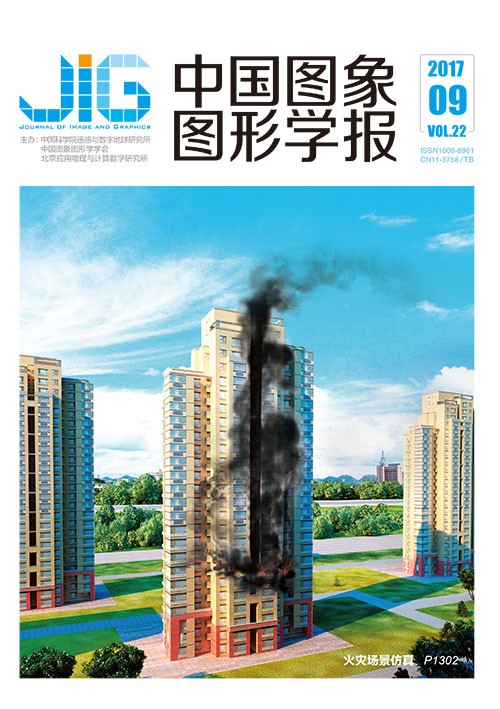
联合判别性低秩类字典与稀疏误差字典学习的人脸识别
摘 要
目的 由于受到光照变化、表情变化以及遮挡的影响,使得采集的不同人的人脸图像具有相似性,从而给人脸识别带来巨大的挑战,如果每一类人有足够多的训练样本,利用基于稀疏表示的分类算法(SRC)就能够取得很好地识别效果。然而,实际应用中往往无法得到尺寸大以及足够多的人脸图像作为训练样本。为了解决上述问题,根据基于稀疏表示理论,提出了一种基于联合判别性低秩类字典以及稀疏误差字典的人脸识别算法。每一类的低秩字典捕捉这类的判别性特征,稀疏误差字典反映了类变化,比如光照、表情变化。方法 首先利用低秩分解理论得到初始化的低秩字典以及稀疏字典,然后结合低秩分解和结构不相干的理论,训练出判别性低秩类字典和稀疏误差字典,并把它们联合起来作为测试时所用的字典;本文的方法去除了训练样本的噪声,并在此基础上增加了低秩字典之间的不相关性,能够提高的低秩字典的判别性。再运用l1范数法(同伦法)求得稀疏系数,并根据重构误差进行分类。结果 针对Extended Yale B库和AR库进行了实验。为了减少算法执行时间,对于训练样本利用随机矩阵进行降维。本文算法在Extended Yale B库的504维每类32样本训练的识别结果为96.9%。在无遮挡的540维每类4样本训练的AR库的实验结果为83.3%,1 760维的结果为87.6%。有遮挡的540维每类8样本训练的AR库的结果为94.1%,1 760维的结果为94.8%。实验结果表明,本文算法的结果比SRC、DKSVD(Discriminative K-SVD)、LRSI(Low rank matrix decomposition with structural incoherence)、LRSE+SC(Low rank and sparse error matrix+sparse coding)这4种算法中识别率最高的算法还要好,特别在训练样本比较少的情况下。结论 本文所提出的人脸识别算法具有一定的鲁棒性和有效性,尤其在训练样本较少以及干扰较大的情况下,能够取得很好地识别效果,适合在实际中进行应用。
关键词
Face recognition by combining a discriminative low-rank class dictionary and sparse error dictionary learning
Cui Yifeng, Li Kaiyu, Hu Yan, Xu Guili, Wang Ping(College of Automation Engineering, Nanjing University of Aeronautics and Astronautics, Nanjing 211106, China) Abstract
Objective Face recognition encounters significant challenges,particularly when images from different persons are similar to one another due to variations in illumination,expression,and occlusion.If we have sufficient training images of each person,which can span the facial variations of that person under testing conditions,then sparse representation-based classification (SRC) can achieve promising results.In many applications,however,the problems of small size of samples and lack of sufficient training images for each person are particularly significant.To solve these problems,this study presents a joint face recognition algorithm between a low-rank class dictionary and sparse error dictionary learning based on theory of sparse representation.The low-rank dictionary of each individual is a class-specific dictionary that captures the discriminative feature of an individual.The sparse error dictionary represents intra-class variations,such as illumination and expression changes.Method An initial low-rank decomposition dictionary and a sparse dictionary are obtained based on theory of low-rank decomposition.Then,combining theories of low-rank decomposition and structural irrelevance,the discriminative low-rank class dictionary and the sparse error dictionary are trained and subsequently merged as the dictionary that will be applied to the test part.Our method decomposes raw training data into a set of representative bases with corresponding sparse errors to efficiently model face images.We further promote structural incoherence among the bases learned from different classes.These bases are encouraged to be as independent as possible due to the regularization on structural incoherence.Additional discriminating capability is provided to the original low-rank models to improve performance.A sparse coefficient is acquired according to the L1 norm method (homotopy method).Test samples can be classified based on the reconstruction error. Result Experiments are conducted on the Extended Yale B and AR databases.A random matrix is used to reduce the dimensions of the training samples to shorten execution time.In the Extended Yale B database,which consists of samples with 504 dimensions,32 training samples are selected from each class.The result of the recognition rate that applies the proposed algorithm is 96.9%.Among the samples with 540 dimensions and without occlusion in the AR database,4 training samples are selected from each class.The result of the recognition rate is 83.3%.For the samples with 1 760 dimensions,the recognition rate is 87.6%.Among the samples with 540 dimensions and with occlusion,8 training samples are selected from each class.The recognition rate is 94.1%.The result of experiment on the training samples with 1 760 dimensions and with occlusion is 94.8%.The experiments show that the results of the proposed algorithm are better than the highest recognition rates of the SRC(Sparse representation-based classifier),DKSVD(Discriminative K-SVD),LRSI(Low rank matrix decomposition with structural incoherence) and LRSE+SC(Low rank and sparse error matrix+ sparse coding) algorithms,particularly in cases with insufficient training samples.The experiment in which all the occlusion images are used as the training samples and the unobstructed images are used as the test samples is first conducted to illustrate the importance of sparse error bases,and the recognition rate of the proposed algorithm is 43.6%.then we exchange training samples and test samples and the recognition rate of the proposed algorithm is 83.1%.The sparse coefficient in the test phase cannot remove interference because the sparse error dictionary lacks the composition of wearing scarves and sunglasses.Consequently,the recognition rate is significantly reduced.When occlusion images are used as training samples and unobstructed images are used as test samples,the interference is considerably smaller than the interference when wearing scarves and sunglasses although the sparse errors lack the composition of light and expression changes.Thus,the recognition rate is significantly higher than the former.In practical applications,only sparse error bases are sufficient,particularly in cases where images are disturbed to a high extent,and the recognition effect can be improved.Conclusion The face recognition algorithm proposed in this study is robust and effective and can achieve an ideal recognition effect,particularly when training samples are insufficient or face recognition is disturbed considerably.The algorithm is suitable for practical applications.
Keywords
|



 中国图象图形学报 │ 京ICP备05080539号-4 │ 本系统由
中国图象图形学报 │ 京ICP备05080539号-4 │ 本系统由